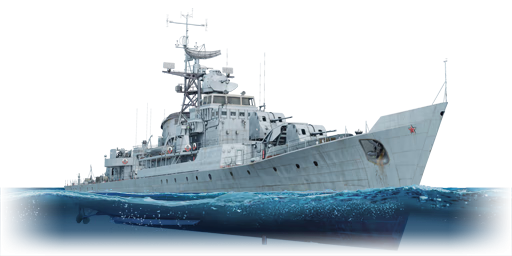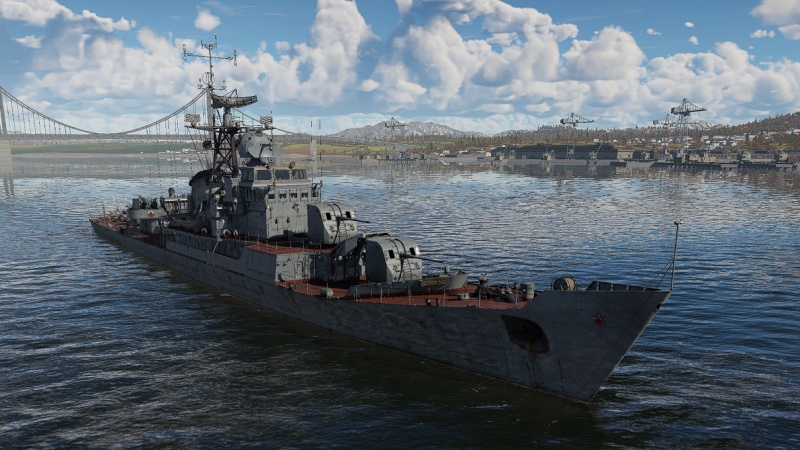Yenot
Contents
Description
The Pr.50, SKR Yenot is a rank V Soviet frigate with a battle rating of 4.0 (AB/RB/SB). It was introduced in Update "Raining Fire".
General info
Survivability and armour
Talk about the vehicle's armour. Note the most well-defended and most vulnerable zones, e.g. the ammo magazine. Evaluate the composition of components and assemblies responsible for movement and manoeuvrability. Evaluate the survivability of the primary and secondary armaments separately. Don't forget to mention the size of the crew, which plays an important role in fleet mechanics. Save tips on preserving survivability for the "Usage in battles" section. If necessary, use a graphical template to show the most well-protected or most vulnerable points in the armour.
Mobility
Write about the ship's mobility. Evaluate its power and manoeuvrability, rudder rerouting speed, stopping speed at full tilt, with its maximum forward and reverse speed.
| Mobility Characteristics | |||
|---|---|---|---|
| Game Mode | Upgrade Status | Maximum Speed (km/h) | |
| Forward | Reverse | ||
| AB | |||
| Upgraded | 77 | 27 | |
| RB/SB | |||
| Upgraded | 55 | 20 | |
Modifications and economy
Armament
Primary armament
The Yenot gets access to three 100 mm B-34 naval cannons which are quite effective against enemy vessels. The weapons fire 15 rounds per minute, which is relatively good for a weapon of its size, but suffers from a slow traverse rate similar to other Soviet naval cannons. The Yenot gets access to three shells: a standard HE shell, a HE-TF time fuse shell or a HE-VT proximity-fused shell. Of these, the HE shell is ideal against naval targets while the HE-VT is the most effective against aerial targets.
| Penetration statistics | |||||||
|---|---|---|---|---|---|---|---|
| Ammunition | Type of warhead |
Penetration @ 0° Angle of Attack (mm) | |||||
| 100 m | 1,000 m | 2,000 m | 3,000 m | 4,000 m | 5,000 m | ||
| F-56 HE | HE | 24 | 24 | 24 | 24 | 24 | 24 |
| ZS-56 HE | HE-TF | 24 | 24 | 24 | 24 | 24 | 24 |
| ZS-56R HE-VT | HE-VT | 16 | 16 | 16 | 16 | 16 | 16 |
| Shell details | ||||||||||||
|---|---|---|---|---|---|---|---|---|---|---|---|---|
| Ammunition | Type of warhead |
Velocity (m/s) |
Projectile mass (kg) |
Fuse delay (m) |
Fuse sensitivity (mm) |
Explosive mass (TNT equivalent) (kg) |
Ricochet | |||||
| 0% | 50% | 100% | ||||||||||
| F-56 HE | HE | 900 | 15.8 | 0 | 0.1 | 1.93 | 79° | 80° | 81° | |||
| ZS-56 HE | HE-TF | 900 | 15.6 | 0 | 0.1 | 1.93 | 79° | 80° | 81° | |||
| Proximity-fused shell details | ||||||||||||
|---|---|---|---|---|---|---|---|---|---|---|---|---|
| Ammunition | Type of warhead |
Velocity (m/s) |
Projectile mass (kg) |
Fuse delay (m) |
Fuse sensitivity (mm) |
Arming distance (m) |
Trigger radius (m) |
Explosive mass (TNT equivalent) (kg) |
Ricochet | |||
| 0% | 50% | 100% | ||||||||||
| ZS-56R HE-VT | HE-VT | 900 | 15.9 | 0 | 0.1 | 270 | 15 | 1.23 | 79° | 80° | 81° | |
Secondary armament
The Yenot carries two dual 37 mm 70-K mounts for anti-aircraft defence. The 70-K is the standard Soviet anti-aircraft gun and serves as a reliable counterpart to the 40 mm Bofors gun used by the allied nations. This gun is extremely similar to the Bofors as it features a similar design, and fires continuously rather than needing to reload. The guns will eventually jam, but the time it takes to jam the weapons is very long so jamming is not a great issue. The weapon gets access to three belts - default, AP and HE. The HE belt is usually the best belt as it is the most effective against enemy aircraft.
- Universal: HEF-T · AP-T · HEF-T · HEF-T · AP-T
- 37 mm HE clips: HEF-T · HEF-T · HEF-T · HEF-T · AP-T
- 37 mm AP clips: AP-T · AP-T · AP-T · AP-T · HEF-T
| Penetration statistics | |||||||
|---|---|---|---|---|---|---|---|
| Ammunition | Penetration @ 0° Angle of Attack (mm) | ||||||
| 10 m | 100 m | 500 m | 1,000 m | 1,500 m | 2,000 m | ||
| HEF-T | 3 | 3 | 3 | 3 | 3 | 3 | |
| AP-T | 79 | 76 | 63 | 51 | 41 | 32 | |
| Shell details | ||||||||||||
|---|---|---|---|---|---|---|---|---|---|---|---|---|
| Ammunition | Velocity (m/s) |
Projectile mass (kg) |
Fuse delay (m) |
Fuse sensitivity (mm) |
Explosive mass (TNT equivalent) (g) |
Ricochet | ||||||
| 0% | 50% | 100% | ||||||||||
| HEF-T | 880 | 0.72 | 0 | 0.1 | 56.98 | 79° | 80° | 81° | ||||
| AP-T | 880 | 0.76 | - | - | - | 47° | 60° | 65° | ||||
Additional armament
The Yenot gets access to two 533 mm 53-38 torpedoes. The 53-38 torpedo is also found on most Soviet WWII-era destroyers, and is relatively mediocre as far as torpedoes go. In terms of damage-dealing capabilities, the torpedo is decidedly mediocre, having more explosive filler (300 kg of TNT) than the American torpedoes but less than the British and Japanese ones. However, the main drawback of the torpedo is its range - without the "torpedo mode" modification, the 53-38s are restricted to a range of just 4 kilometres, meaning that they are tied for the shortest-range large-ship mounted torpedoes along with the Italian destroyer torpedoes. The torpedo mode modification is necessary for hitting longer-ranged targets, but reduces the torpedo's speed to just 56 km/h. In general, these torpedoes are a potent weapon against enemy bluewater ships if you can get close enough to fire them. On the Yenot, these may be used as a close-in backup weapon against ships that outgun you.
Usage in battles
Describe the technique of using this ship, the characteristics of her use in a team and tips on strategy. Abstain from writing an entire guide – don't try to provide a single point of view, but give the reader food for thought. Talk about the most dangerous opponents for this vehicle and provide recommendations on fighting them. If necessary, note the specifics of playing with this vehicle in various modes (AB, RB, SB).
Pros and cons
Summarise and briefly evaluate the vehicle in terms of its characteristics and combat effectiveness. Mark its pros and cons in the bulleted list. Try not to use more than 6 points for each of the characteristics. Avoid using categorical definitions such as "bad", "good" and the like - use substitutions with softer forms such as "inadequate" and "effective".
Pros:
Cons:
History
The Project 50 frigate, NATO reporting name Riga-class, was a class of frigates built for the Soviet Navy in the 1950s. The Soviet designation for these ships was Storozhevoi Korabl (escort ship) Project 50 Gornostay (Ermine stoat). The Riga class was analogous to World War II era destroyer escorts.
These ships were a smaller and simpler version of the Kola class frigate. According to Conway's, this simpler group of ships were ordered by Joseph Stalin who was concerned about the cost of large ships. The class introduced high pressure steam turbines and new radars into Soviet service. The bridge, gun turrets, and magazines were covered in 8 mm (0.31 in)-thick armour. The main armament comprised three single dual-purpose 100 mm (3.9 in) guns with remote power control and a single Yakor type fire control director. The machinery comprised two TV-9 steam turbines with two boilers and had initial problems with reliability.
The Project 50 Riga class was a rather simplistic and straight forward design. With their basic capabilities, moderate size and ease of operation, they made perfect export vessels for smaller navies where such ships could easily fill the multi-purpose role, taking the place of large minesweepers and actual destroyers.
There was a modernisation programme designated Project 50 A in the late 1950s early 1960s. This included fitting anti-submarine rocket launchers (RBU-2500) new radar and adding permanent ballast for improved stability.[1]
Media
- Skins
See also
- Related development
External links
Paste links to sources and external resources, such as:
- topic on the official game forum;
- other literature.
| Yantar Baltic Shipyard (Прибалтийский судостроительный завод «Янтарь») | |
|---|---|
| Frigates | |
| Project 50 | Yenot · Rosomacha · Karl Marx* |
| Project 35 | SKR-7 |
| *Tur in East German service | |
| USSR frigates | |
|---|---|
| Pr. 50 | Rosomacha · Yenot |
| Pr. 159 | SKR-1 |
| Pr. 35 | SKR-7 |
| Pr. 1331M | MPK Pr.1331M |





